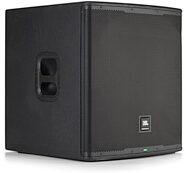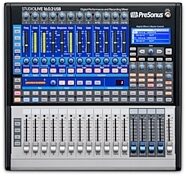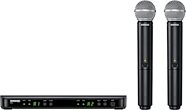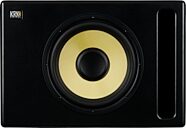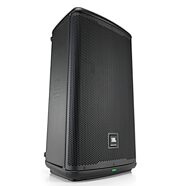dbx 223 Stereo 2-Way, Mono 3-Way Crossover
No longer available at zZounds


Engineered for versatility, this dbx crossover features Linkwitz-Riley 24dB-per-octave filters, a built-in power unit and balanced ¼-inch inputs and outputs.
Overview
Let's take a look at the construction features of the dbx 223. At first glance, you'll notice the units are great looking. As you turn the controls something else becomes apparent; these units are extremely well built. The controls exude great precision, and the feel is a solid "click." Also, when you open the box, you won't find the external power supply that accompanies most processors in this price range. That's because we know how difficult external power supplies can be to work with and even though it costs a little more we put the high quality power supply right in the unit. All the inputs and outputs are TRS differentially balanced 1/4" jacks that are bolted down to the chassis. This "nutting down" of the jacks insures that even if someone stomps on a cable plugged into the unit, it's not going to tear up the circuit board inside. All dbx crossovers all feature Linkwitz-Riley 24 dB per octave filters, the professional standard. But then again, what did you expect?
Via a switch on the back panel, you first select whether you're operating your system in stereo 2-way or mono 3-way. Then you also set, on the back panel, whether or not you want to mono sum the LF (subwoofer) out. (Most systems that use a subwoofer are mono subbed to take advantage of amplifier power and because low frequencies are non-directional.) Back panel switches allow you to select the range of the crossover frequencies individually for both channels. The crossover frequency controls have a green LED… read more that indicates when the x10 switch on the back panel is activated (we wouldn't make you check the switch position on the back every time you wonder where it's set). All these switches are on the back panel because it could be disastrous if you were to change them mid-program. On the front panel you'll notice there are LEDs that indicate whether the unit is in mono or stereo mode. Each channel has an input gain control for proper level setting. There's a recessed 40 Hz low cut (HPF) on each channel to remove unwanted low frequencies. Both the low and high outputs on each channel have a gain control ranging from - to +6 dB to allow muting of individual outputs and for level matching. Also, these outputs each have phase reverse switches that will help get you out of a bind without having to reconfigure your system. These phase reverse switches may be internally reconfigured as mute switches.
You'll get great performance, all the features you'd expect from a professional product and the knowledge that you're buying a processor from the people that have been producing the worlds finest processors for over 20 years. The technology that made dbx famous brings you a dbx crossover that has been tested to the highest professional standards at a price that's just too low to admit!
Features
TRS differentially balanced ins and outs
Mode switch for stereo 2-way or mono 3-way operation
Low frequency summed (subwoofer) output
x10 range switch on both channels
40 Hz high pass (low cut) filter both channels
Phase reverse switch on all outputs
Individual level controls on all outputs
24 dB per octave Linkwitz-Riley filters (the professional standard)
Stereo/Mono status LEDs indicate the selected mode
dbx 2 year parts and labor as standard
CSA NRTL/C approved
CE compliant read less
Via a switch on the back panel, you first select whether you're operating your system in stereo 2-way or mono 3-way. Then you also set, on the back panel, whether or not you want to mono sum the LF (subwoofer) out. (Most systems that use a subwoofer are mono subbed to take advantage of amplifier power and because low frequencies are non-directional.) Back panel switches allow you to select the range of the crossover frequencies individually for both channels. The crossover frequency controls have a green LED… read more that indicates when the x10 switch on the back panel is activated (we wouldn't make you check the switch position on the back every time you wonder where it's set). All these switches are on the back panel because it could be disastrous if you were to change them mid-program. On the front panel you'll notice there are LEDs that indicate whether the unit is in mono or stereo mode. Each channel has an input gain control for proper level setting. There's a recessed 40 Hz low cut (HPF) on each channel to remove unwanted low frequencies. Both the low and high outputs on each channel have a gain control ranging from - to +6 dB to allow muting of individual outputs and for level matching. Also, these outputs each have phase reverse switches that will help get you out of a bind without having to reconfigure your system. These phase reverse switches may be internally reconfigured as mute switches.
You'll get great performance, all the features you'd expect from a professional product and the knowledge that you're buying a processor from the people that have been producing the worlds finest processors for over 20 years. The technology that made dbx famous brings you a dbx crossover that has been tested to the highest professional standards at a price that's just too low to admit!
Features
TRS differentially balanced ins and outs
Mode switch for stereo 2-way or mono 3-way operation
Low frequency summed (subwoofer) output
x10 range switch on both channels
40 Hz high pass (low cut) filter both channels
Phase reverse switch on all outputs
Individual level controls on all outputs
24 dB per octave Linkwitz-Riley filters (the professional standard)
Stereo/Mono status LEDs indicate the selected mode
dbx 2 year parts and labor as standard
CSA NRTL/C approved
CE compliant read less
Specs
Input
Connectors: 1/4" TRS
Type: Electronically balanced/unbalanced, RF filtered
Impedance: Balanced > 50 k, unbalanced > 25 k
Max Input Level: > +21 dBu balanced or unbalanced
CMRR: > 40 dB, typically > 50 dB at 1 kHz
Output
Connectors: 1/4" TRS
Type: Impedance-balanced/unbalanced, RF filtered
Impedance: Balanced 200 , unbalanced 100
Max Output Level: > +21 dBu balanced/unbalanced into 2 k or greater
Performance
Bandwidth: 20 Hz to 20 kHz, +0/-0.5 dB
Frequency Response: < 3 Hz to > 90 kHz, +0/-3 dB
Signal-to-Noise: Ref: +4 dBu, 22 kHz measurement bandwidth
Stereo Mode: Mono Mode:
Low Output: > 94 dB > 94 dB
Mid Output: > 93 dB
High Output: > 92 dB > 92 dB
Dynamic Range: > 114 dB, unweighted, any output
THD+Noise: < 0.004% at +4 dBu, 1 kHz
< 0.04% at +20 dBu, 1 kHz
Interchannel Crosstalk: < -80 dB, 20 Hz to 20 kHz
Crossover Frequencies
Stereo Mode:
Low/High: 45 to 960 Hz or 450 Hz to 9.6 kHz (x10 setting)
Mono Mode:
Low/Mid: 45 to 960 Hz or 450 Hz to 9.6 kHz (x10 setting)
Mid/High: 45 to 960 Hz or 450 Hz to 9.6 kHz (x10 setting)
Filter Type: Linkwitz-Riley, 24 dB/octave, state-variable
Function Switches
Front Panel:
Low Cut: Activates 40 Hz Butterworth, 12 dB/octave high-pass filter, one switch per channel.
Phase Invert: Inverts the phase at the output, one switch per output.
Rear Panel:
x1/x10: Multiplies the low-high(mono: low/mid and high/mid) crossover frequency range of the front-panel markings by a factor of 1 or 10, one switch per channel.
Mode: Selects stereo 2-way or mono 3-way operation and disables all LEDs for controls that are non-functional in the selected mode.
LF Sum: Selects normal (stereo) or mono-summed low frequency operation and disables Ch 2's low output phase invert LED to indicate that this output is not operational in the LF sum mode.
Indicators
Stereo Operation: Green LED
Mono Operation: Yellow LED
Low Cut: Red LED per channel
x10: Green LED per channel
Phase Invert: Red LED per output (2 per channel)
Power Supply
Operating Voltage: 100 VAC 50/60 Hz; 120 VAC 60 Hz 230 VAC50 HZ
Power Consumption: 15 Watts
Mains Connection: IEC 320 receptacle
Physical
Dimensions (H x W x D): 1.75 x 19 x 6.9 in. (4.4 x 48.3 x 17.5 cm)
Connectors: 1/4" TRS
Type: Electronically balanced/unbalanced, RF filtered
Impedance: Balanced > 50 k, unbalanced > 25 k
Max Input Level: > +21 dBu balanced or unbalanced
CMRR: > 40 dB, typically > 50 dB at 1 kHz
Output
Connectors: 1/4" TRS
Type: Impedance-balanced/unbalanced, RF filtered
Impedance: Balanced 200 , unbalanced 100
Max Output Level: > +21 dBu balanced/unbalanced into 2 k or greater
Performance
Bandwidth: 20 Hz to 20 kHz, +0/-0.5 dB
Frequency Response: < 3 Hz to > 90 kHz, +0/-3 dB
Signal-to-Noise: Ref: +4 dBu, 22 kHz measurement bandwidth
Stereo Mode: Mono Mode:
Low Output: > 94 dB > 94 dB
Mid Output: > 93 dB
High Output: > 92 dB > 92 dB
Dynamic Range: > 114 dB, unweighted, any output
THD+Noise: < 0.004% at +4 dBu, 1 kHz
< 0.04% at +20 dBu, 1 kHz
Interchannel Crosstalk: < -80 dB, 20 Hz to 20 kHz
Crossover Frequencies
Stereo Mode:
Low/High: 45 to 960 Hz or 450 Hz to 9.6 kHz (x10 setting)
Mono Mode:
Low/Mid: 45 to 960 Hz or 450 Hz to 9.6 kHz (x10 setting)
Mid/High: 45 to 960 Hz or 450 Hz to 9.6 kHz (x10 setting)
Filter Type: Linkwitz-Riley, 24 dB/octave, state-variable
Function Switches
Front Panel:
Low Cut: Activates 40 Hz Butterworth, 12 dB/octave high-pass filter, one switch per channel.
Phase Invert: Inverts the phase at the output, one switch per output.
Rear Panel:
x1/x10: Multiplies the low-high(mono: low/mid and high/mid) crossover frequency range of the front-panel markings by a factor of 1 or 10, one switch per channel.
Mode: Selects stereo 2-way or mono 3-way operation and disables all LEDs for controls that are non-functional in the selected mode.
LF Sum: Selects normal (stereo) or mono-summed low frequency operation and disables Ch 2's low output phase invert LED to indicate that this output is not operational in the LF sum mode.
Indicators
Stereo Operation: Green LED
Mono Operation: Yellow LED
Low Cut: Red LED per channel
x10: Green LED per channel
Phase Invert: Red LED per output (2 per channel)
Power Supply
Operating Voltage: 100 VAC 50/60 Hz; 120 VAC 60 Hz 230 VAC50 HZ
Power Consumption: 15 Watts
Mains Connection: IEC 320 receptacle
Physical
Dimensions (H x W x D): 1.75 x 19 x 6.9 in. (4.4 x 48.3 x 17.5 cm)
Documents and Manuals
For support or warranty questions, please contact the manufacturer:
Phone: 844-776-4899
Web: https://www.dbxpro.com/en/support
Phone: 844-776-4899
Web: https://www.dbxpro.com/en/support
No longer available at zZounds
In most cases, a product is unavailable because it has been discontinued by the manufacturer
This is a carousel with product cards. Use the previous and next buttons to navigate.



